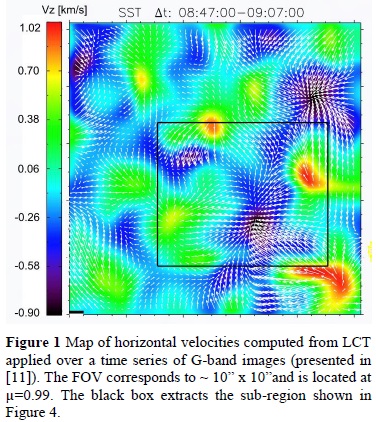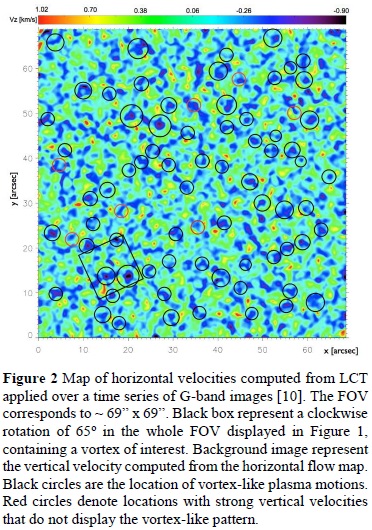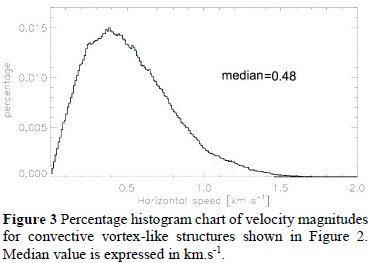Serviços Personalizados
Journal
Artigo
Indicadores
-
 Citado por SciELO
Citado por SciELO -
 Acessos
Acessos
Links relacionados
-
 Citado por Google
Citado por Google -
 Similares em
SciELO
Similares em
SciELO -
 Similares em Google
Similares em Google
Compartilhar
Tecciencia
versão impressa ISSN 1909-3667
Tecciencia vol.11 no.20 Bogotá jan./jun. 2016
https://doi.org/10.18180/tecciencia.2016.20.1
DOI: http://dx.doi.org/10.18180/tecciencia.2016.20.1
Influence of a plasma swirl motion on fine magnetic concentrations in the solar photosphere
Influencia del movimiento de vórtices de plasma en concentraciones magnéticas finas en la fotósfera solar
Santiago Vargas Domínguez1*, Judith Palacios2, Laura Balmaceda3, Iballa Cabello3, Vicente Domingo4
1 Universidad Nacional de Colombia - Sede Bogotá - Observatorio Astronómico Nacional; Bogotá, Colombia.
2 Universidad de Alcalá; Alcalá, Spain
3 ICATE-CONICET, Argentina
4 Universidad de Valencia; Valencia, Spain
* Corresponding Author E-mail: svargasd@unal.edu.co
How to cite: Vargas, S. et al., Influence of a plasma swirl motion on fine magnetic concentrations in the solar photosphere, TECCIENCIA, Vol. 11 No. 20, 1-4, 2016, DOI: http://dx.doi.org/10.18180/tecciencia.2016.20.1
Received: 24 Nov 2015 Accepted: 15 Jan 2016 Available Online: 29 Feb 2016
Abstract
High-resolution observations from ground-based (Solar Swedish Telescope) and space-borne (Hinode) solar telescopes acquired data with various filters, obtaining images of a quiet Sun region populated with small-scale magnetic elements. The region is also characterized by the presence of photospheric swirl convective plasma structures. This work abridges the results of different analysis applied over time series of images to follow the evolution of magnetic features aiming to establish the influence of the plasma vortices on their motions.
Keywords: Solar Physics, Magnetic Field, Photospheric Plasma.
Resumen
Observaciones solares en alta resolución desde telescopios en tierra (SST) y en el espacio (Hinode) registraron datos con diferentes filtros, obteniendo imágenes de una región del Sol en calma poblada con pequeños elementos magnéticos. La región se caracteriza también por la presencia de vórtices convectivos de plasma fotosférico. Este trabajo condensa los resultados de diferentes análisis aplicados sobre series temporales de imágenes con miras a realizar un seguimiento de la evolución y dinámica de estructuras magnéticas, y de esta forma establecer la influencia de los vórtices de plasma sobre ellas.
Palabras clave: Física Solar, Campo Magnético, Plasma Fotosférico.
1. Introduction
Increasing technological developments in solar instrumentation have revolutionize the acquisition of time series of filtergrams and solar data that enable to follow the evolution and dynamics of solar phenomena, in particular at the finest temporal and spatial scales. Physical conditions and processes occurring at those scales are essential for the configuration and structure of others taking place at larger scales, from the surface to upper layers in the solar atmosphere.
Photospheric plasma motions are particularly interesting as they have impact on the footpoints of magnetic loops and could be directly affecting the magnetic configuration throughout all the solar atmosphere. The interplay between plasma and magnetic fields is therefore a crucial topic that has been studied in recent years (see [1] and references therein).
Small-scale convectively driven vortex-type motions have been discovered by [2] using high-resolution observations of the solar photosphere. Recent works reported the discovery of abundant "magnetic tornadoes" in the solar atmosphere [3]. Furthermore, different observations suggest that an important part of the magnetic flux in quiet Sun regions might be the result of the emergence of small-scale and short-lived magnetic loops (see [4] [5]) and that can also contribute to heating of the solar chromosphere and corona [6] [7]. The connection between the emergence of these small-scale magnetic features, the vortex-like convective motions and the subsequent evolution of the upper photosphere is therefore an important ingredient for understanding the configurations, activity and evolution of the Sun. Various works propose braiding of magnetic field lines at the photospheric level as a direct consequence of the effect of swirl plasma motions, and the subsequent outcome on promoting reconnection in upper layers where those field lines get squeezed (denser), as mentioned in [1] [3] [4] [8].
This work recapitulates various recent ideas and results dealing with the properties of vortices [5] [8] [10] [11] since the discovery of swirling fine-scale convective motions in the solar photosphere.
2. Observations
A series of observations focus on the evolution of quiet Sun regions, [5] [8] [10] [11] [12], utilizing several long multi-wavelength data series. These were acquired from both ground-based (Solar Swedish Tower, SST) and space-borne (Hinode) high-cadence and high-resolution data, including SOT-SP data, in a joint campaign of the Hinode Operation Program (HOP) 14, in September 2007.
The specific quiet Sun region under analysis (for heliospheric angle θ, with µ=cosθ=0.99) was followed from 08:40 to 9:20 UT on 29 September 2007. Data from SST and Hinode spanning 19 min and 40 min, with a cadence of 15 s and 35 s respectively.
Diffraction-limited SST data, taken in G-band and G-cont, were restored by MFBD, whilst Hinode obtained multispectral data from SOT-FG in CN, Mg II, Ca II and also SP in Fe I lines. In these series we have thoroughly studied vortex flows and their statistical occurrences, horizontal velocities by measuring horizontal proper motions, divergence and vorticity; but we have also studied bright point statistics and magnetic field intensification, clearly highlighting the importance of the smallest-scale magnetic element observations.
3. Dynamics of photospheric plasma
Solar plasma in the photosphere shows a rapid evolution of the order of a few seconds. Time series of images enables to follow the evolution of the granular pattern and therefore to measure the proper motion of structures.
SST/G-band and Hinode/CN time series are employed to compute the horizontal proper motions of structures by means of a local correlation tracking (LCT) technique, [13] [14] implemented by [15]. This powerful technique is based on using a tracking correlation window to find the best correlation in subsequent frames from a time series of images. Maps of horizontal velocities are computed by using a Gaussian tracking window of FWHM 1.0" (roughly half of the typical granular size).
Figure 1 shows the map of horizontal velocities applied over a region with FOV of ∼10"×10", averaged over a 19-min time window. The background image represents the vertical velocities computed from the divergence of the horizontal velocity field, following [13]. Convective vortex-like motions are identified as sinks (darker areas) where the horizontal velocity vectors converge and the vertical velocities have magnitudes up to 0.9 km.s-1.
Applying the same procedure to the whole spatial range in our observations, we can identify the location of multiple vortices and confirm that they are distributed all over the large FOV of ∼69"×69". Figure 2 shows the map of horizontal velocities where circles highlight the vortex-like motions detected in the data. Determination of swirl motions is based on the convergence of horizontal velocity vectors into a central point, as displayed in the example boxed in Figure 1.
By visual inspection it can be determined that vortices are found to be not homogeneously distributed but tend to group in regions resembling the large convective mesogranular and supergranular scales and with a distribution of velocity magnitudes. Figure 3 shows the histogram of horizontal velocity magnitudes (in percentage over computed velocities) extracted from the flow map in Figure 2 in a circular region (radius of ∼2") centered on every detected vortex. Vortices display a characteristic mean speed of 0.48 km. s-1.
4. Influence of plasma motions on magnetic features
In order to study the action of the convective plasma motions, in particular the vortices, on the magnetic configuration of the region, we study the sequence of MgI magnetograms where we identify magnetic elements. Segmentation techniques using intensity thresholding and enhance filtering allow the identification of magnetic features that are mostly distributed along intergranular lanes [9] [10]. Magnetic elements have a typical area of 0.1 square arcsec, and lifetime of 5-10 min as tracked from the time series.
We focus on the region framed in the black box in Figure 1 where there is an intense convergence of horizontal velocities that appears as affecting the dynamics of the region. To study their dynamics and physical properties we plot a sequence of magnetograms where we can easily identify two magnetic features (see upper panels in Figure 4 where the black/white plus signs are used to highlight the corresponding negative/positive magnetic elements).
5. Conclusions
Multi-wavelength observations of quiet Sun regions using ground-based and space-borne telescopes allow the identification of convective vortex-like motions distributed mainly along intergranular lanes in the solar photosphere. A deeper analysis, using sequences of magnetograms, reveals the influence of these vortices affecting the dynamics of magnetic concentrations. In particular we found rotation of magnetic features as if they were being dragged by the action of a vortex (see red lines in the upper row in Figure 4).
Nearby the center of the vortex there are some indications of magnetic field intensification depicted by appearance of G-band bright points [16].
The findings are important in the context of the study of the interplay between plasma and magnetic field that shape the solar atmosphere. In particular on the understanding of the conditions required to heat the solar atmosphere. Magnetic field lines emerging throughout the atmospheric layers could be affected from their base, when the vortex-like motions in the photosphere gather magnetic concentrations and shake the footpoints, therefore changing the topology of the magnetic field in upper layers.
References
[1] Jess, D. B., Mathioudakis, M., Erdélyi, R., Crockett, P. J., Keenan, F. P. & Christian, D. J. 2009, Science, 323, 1582. [ Links ]
[2] Bonet, J. A., Márquez, I., Sánchez Almeida, J., Cabello, I., & Domingo, V. 2008, ApJ, 687, L131. [ Links ]
[3] Wedemeyer-Böhm, S., Scullion, E., Steiner, O., Rouppe van der Voort, L., de La Cruz Rodríguez, J., Fedun, V. and Erdélyi, R., 2012, Nature, 505. [ Links ]
[4] Martínez González M. J. & Bellot Rubio, L. R. 2009 Astrophys. J., 700, 1391. [ Links ]
[5] Palacios, J., Balmaceda, L. A., Vargas Domínguez,S., Cabello, I. & Domingo, V. 2012, in ASP Conference Series, 454, 51. [ Links ]
[6] Wang, Y., Noyes, R. W., Tarbell, T. D., & Title, A. M. 1995, ApJ, 447, 419. [ Links ]
[7] Li, H., Sakurai, T., Ichimito, K., Suematsu, Y., Tsuneta, S., Katsukawa, Y., Shimizu, T., Shine, R. A., Tarbell, T. D., Title, A. M., et al.. 2007, Pub. Astron. Soc. Japan, 59, S643. [ Links ]
[8] Balmaceda, L., Vargas Domínguez, S., Palacios, J., Cabello, I., Domingo, V. 2010, A&A, 513, L6. [ Links ]
[9] Bonet, J. A., Cabello, I., Sánchez, Almeida, J. 2012, A&A, 539, id.A6, 8. [ Links ]
[10] Vargas Domínguez, S., Palacios, J., Balmaceda, L., Cabello, I., & Domingo, V. 2011, Mon. Not. Roy. Astron. Soc., 416, 148. [ Links ]
[11] Vargas Domínguez, S., Palacios, J., Balmaceda, L., Cabello, I., & Domingo, V. 2015, Solar Physics, 290, 301-319. [ Links ]
[12] Cabello et al., in preparation. [ Links ]
[13] November, L. J., & Simon, G. W. 1988, ApJ, 333, 427. [ Links ]
[14] Yi, Z. & Molowny-Horas, R. 1995, A&A 295, 199-205. [ Links ]
[15] Molowny-Horas, R., & Yi, Z. 1994, ITA (Oslo) Internal Rep., 31. [ Links ]
[16] Ishikawa, R., Tsuneta, S., Kitakoshi, Y., et al. 2007, A&A, 472, 911-918. [ Links ]

















